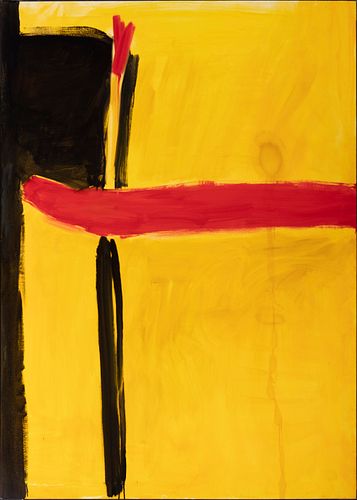JOSÉ GUERRERO (Granada, 1914 - Barcelona, 1991). "Encounter", 1989. Mixed technique on canvas. Signed, titled and dated on the back.
Lot 84
About Seller
Setdart Auction House
Carrer Aragó 346
Barcelona
Spain
Setdart Subastas was born in 2004 and is currently the first online art auction in Spain with solidity, prestige and reliability guaranteed by our more than 60,000 users. Setdart has a young, dynamic and enterprising team ready to successfully manage the purchase and sale of art works through custom...Read more
Categories
Estimate:
$150,000 - $180,000
Absentee vs Live bid
Two ways to bid:
- Leave a max absentee bid and the platform will bid on your behalf up to your maximum bid during the live auction.
- Bid live during the auction and your bids will be submitted real-time to the auctioneer.
Bid Increments
| Price | Bid Increment |
|---|---|
| $0 | $10 |
| $200 | $25 |
| $500 | $50 |
| $1,000 | $100 |
| $3,000 | $200 |
| $5,000 | $500 |
| $10,000 | $1,000 |
| $20,000 | $2,000 |
| $50,000 | $5,000 |
About Auction
By Setdart Auction House
Jun 17, 2021
Set Reminder
2021-06-17 06:15:00
2021-06-17 06:15:00
America/New_York
Bidsquare
Bidsquare : 19th & 20th Century Contemporary Art - Select Lots
https://www.bidsquare.com/auctions/setdart-auction-house/19th-20th-century-contemporary-art---select-lots-7081
Setdart Auction House sofia@setdart.com
Setdart Auction House sofia@setdart.com
- Lot Description
JOSÉ GUERRERO (Granada, 1914 - Barcelona, 1991). "Encounter", 1989. Mixed technique on canvas. Signed, titled and dated on the back. Presents a label from the El Coleccionista gallery in Madrid. Inventory number label: J.G. 868. Origin: Juan Mordó gallery, Madrid; Carles Taché, Barcelona. Exhibitions: "José Guerrero", Carles Taché. March-May, 1990. Listed in the José Guerrero Reasoned Catalog, Vol. 2. José Guerrero Center. 2008. pg. 1211. Measurements: 182 x 130.5 cm; 183 x 131.5 cm (frame). In this painting from the last stage of José Guerrero's life, the traits of a singular plastic character converge, which led the artist to the peak of abstract expressionism, remaining true to himself and maintaining an energetic creative impulse until the end of his days. A Spanish painter and engraver who became a naturalized American citizen, José Guerrero developed his work within abstract expressionism. He began his training at the Escuela de Artes y Oficios in Granada, and soon moved to Madrid to continue his studies at the Escuela Superior de Bellas Artes de San Fernando, where he was a student of Daniel Vázquez Díaz. In 1942 he obtained a scholarship from the Casa de Velázquez, and in 1945 he moved to Paris thanks to a new scholarship, this time granted by the French government. In the French capital he got to know first hand the European avant-garde, and came into contact with the Spanish painters of the School of Paris. Since then, his work is full of avant-garde echoes and Picasso's signs, clearly visible in this work, features that he will abandon in the fifties, when he discovers abstract expressionism in New York. He arrived in New York in 1950, encouraged by his wife, the New York journalist Roxana Pollock, whom he had married a year earlier. In 1954 he exhibited with Joan Miró at the Art Club of Chicago, an exhibition that meant his definitive international projection. His dealer was Betty Parson, one of the most important gallery owners in New York at the time. Guerrero's style then changed completely, showing a profound influence of Rothko and Kline; he definitively abandoned figuration and built compositions where a marked tension between spaces, colors and unrecognizable objects was evident. He returns to Spain in 1965, and participates in the creation of the Museum of Abstract Art in Cuenca. He soon returned to New York, although he continued to make trips to Spain. His production, which continues to be characterized by the power of masses of color, planes and lines, is influenced at this time by Clyfford Still and Barnett Newman. Today, José Guerrero is recognized as one of the most outstanding Spanish painters of the New York School. He achieved early recognition, being named Knight of the Order of Arts and Letters by the French government in 1959. Likewise, in 1976 his first anthological exhibition was held in his hometown. In 1984 he received the Gold Medal of Fine Arts, and in 1989 he was decorated by the Rodriguez Acosta Foundation. In 2000 the art center that bears his name was inaugurated in Granada, created from the donation made by his widow to the Provincial Council. He is also represented in various museums and collections, including the Guggenheim Museum, the MOMA and the Metropolitan in New York, the Reina Sofia in Madrid, the British Museum and the Patio Herreriano in Valladolid.
- Shipping Info
-
In-house shipping available. Please inquire at admin@setdart.com.
-
- Buyer's Premium



 EUR
EUR CAD
CAD AUD
AUD GBP
GBP MXN
MXN HKD
HKD CNY
CNY MYR
MYR SEK
SEK SGD
SGD CHF
CHF THB
THB
















